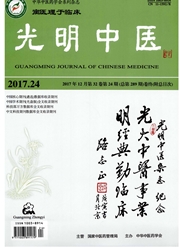

 中文摘要:
中文摘要:
目的观察针刀治疗对寰枢关节紊乱型颈椎病患者临床疗效及椎-基动脉血流速度的影响。方法选择寰枢关节紊乱型颈椎病并椎-基动脉血流速度异常患者40名,按随机数字表法随机分为针刀治疗组(治疗组)和针刺治疗组(对照组)各20例,治疗20天后进行检测下列观察指标:1经颅多普勒(TCD)检测的椎-基底动脉(VBA)收缩峰期血流速度(Vp)、舒张末期血流速度(Vd)、血管搏动指数(PI)各指标;2临床症状改善情况。结果 140例寰枢关节紊乱型颈椎病患者的TCD表现都为椎-基底动脉(VBA)血流速度加快;2对40例患者的椎-基底动脉(VBA)血流速度进行治疗前后统计比较,均有改善,治疗组VBA的Vp、Vd治疗前后比较,有显著性差异(P〈0.01);对照组VBA的Vp、Vd治疗前后比较,差异有统计学意义(P〈0.05);两组方法对VBA的Vp、Vd组间疗效比较,差异有统计学意义,治疗组优于对照组(P〈0.05);两组PI值治疗前后和治疗后组间比较,差异均无统计学意义(P〉0.05);3两组临床症状改善情况,治疗组总有效率95%,对照组总有效率80%,治疗组优于对照组。结论寰枢关节紊乱颈椎病患者的椎-基底动脉(VBA)血流速度以加快为主;两组疗法均能有效改善椎-基动脉血流速度,改善临床症状,并且针刀疗法优于针刺疗法,针刀疗法治疗次数少,能解决频繁针灸耗时、影响工作等问题,值得在各级医院进行推广应用。
 英文摘要:
英文摘要:
Objective To observe the clinical effect of acupotomy on the atlantoaxial joint disorder cervical spondylosis and the vertebral basilar artery blood flow velocity. Methods Selecting 40 cases of patients with atlantoaxial joint disorder cervical spondylosis with abnormal the vertebral basilar artery blood flow velocity,they were randomly divided into acupotomy treatment group( treatment group) and acupuncture group( control group) with 20 cases in each group. After treatment of 20 days,indexes were observed and detected as follows:( ⅰ) transcranial Doppler( TCD) detection of vertebral basilar artery( VBA) peak systolic velocity( Vp),end diastolic velocity( Vd) and pulsatility index( PI) of each index;( ⅱ) the improvement of clinical symptoms. Results( ⅰ) 40 cases of atlantoaxial joint disorder patients with abnormal artery blood velocity of vertebral-based TCD showed vertebral basilar artery( VBA) blood flow speed;( ⅱ) 40 cases of patients with vertebral basilar artery( VBA) before and after treatment with abnormal statistics of blood flow velocity of vertebral basilar artery comparison,the velocity of blood flow( VBA) were improved,the Vd and Vd of VBA were compared those before treatment in the treatment group,and there was significant difference( P〈0. 01). Vp and Vd of VBA before treatment in the control group were compared,and the difference was statistically significant( P〈0. 05). Vp and Vd of VBA of the two groups were compared,the difference has statistical significance,and the treatment group was better than the control group( P〈0. 05). Before and after treatment,the PI value of the two groups was compared,and the difference was not statistically significant( P〉0. 05).( ⅲ) In the aspect of the improvement of clinical symptoms of the two groups,the total effective rate of the treatment group and the control group was 95% and 80%,respectively,and the treatment group was superior to control group. Conclusion The at
 同期刊论文项目
同期刊论文项目
 同项目期刊论文
同项目期刊论文
 期刊信息
期刊信息
